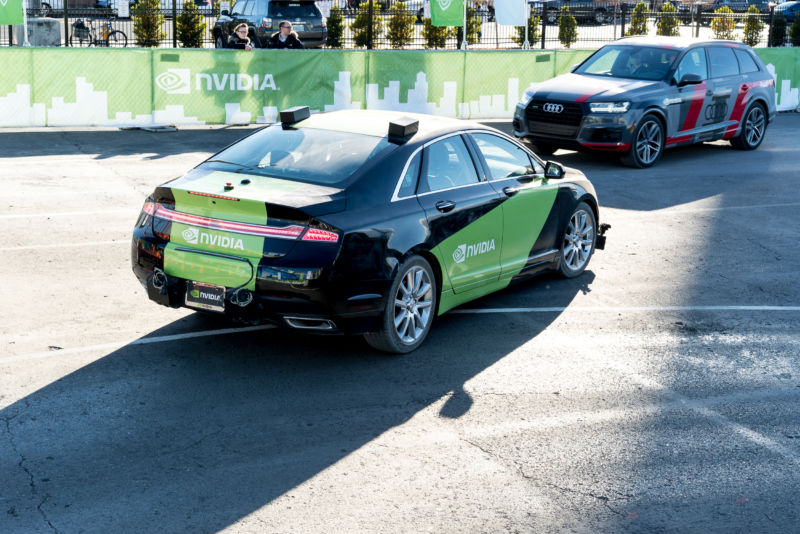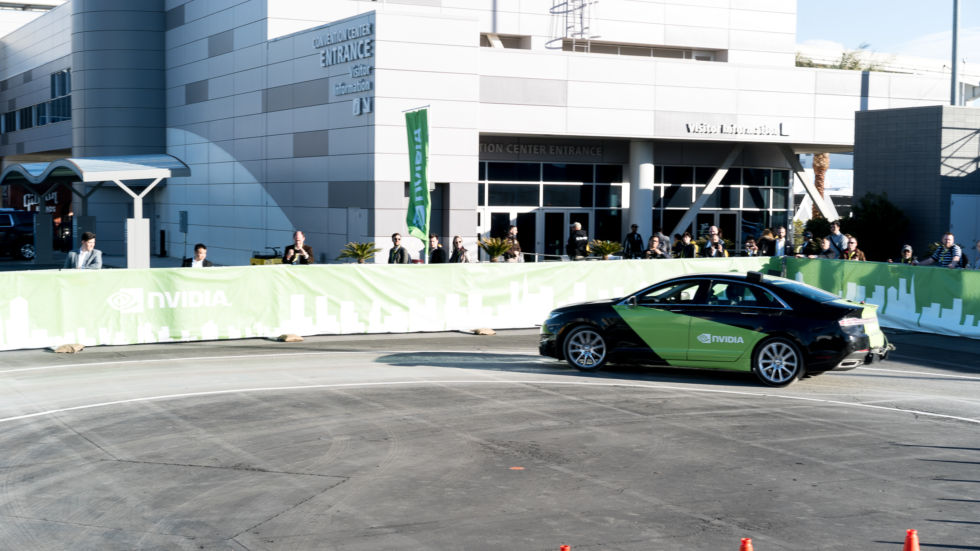
Sitting in the passenger seat of a car affectionately known at Nvidia as "BB8" is an oddly terrifying experience. Between me and the driver's seat is a centre panel covered in touchscreens detailing readings from the numerous cameras and sensors placed around the car. There's also a large red button helpfully labelled "stop."
As BB8 pulls away to take me on a short ride around a dedicated test track on the north side of the Las Vegas convention centre—with no-one in the driver's seat, mind you—it's hard to resist keeping a hand hovering over that big red button. After all, it's not every day that you consciously put your life in the hands of a computer.
The steering wheel jerks and turns as BB8 sweeps around a corner at a cool 10 miles per hour, neatly avoiding a set of traffic cones while remaining within the freshly painted white lines of the makeshift circuit. After three smooth laps, two Nvidia employees wheel out an obstacle—a large orange panel—into the middle of track, which BB8 deftly avoids.
Aside from a remote kill switch held by a chaperone on the outside of the track, BB8 isn't being controlled by a remote, nor has it been pre-programmed with the layout of the track. It is a fully realised, near-fully automated self-driving car that works today. And as unnerving and as foreign as it is to be driven around in BB8, there's no doubt in my mind that this is the future of driving—and it's coming far sooner than you might think.
By 2020 (a "hard deadline" I'm told), Nvidia plans to release an almost entirely automated, self-driving car that anyone can buy. This "Level 4" automatic vehicle—where the AI can control the vehicle in all but a few environments such as severe weather—will be built in conjunction with automotive legend Audi, and it will be powered by Nvidia's PX2 board. The latter combines Pascal-powered GPUs with custom ARM chips to analyse signals, objects, pedestrians, signs, or whatever else it is a car needs to know in order to navigate our roads.
Nvidia claims PX2 can perform 24 trillion deep learning operations per second—enough to make a Level 4 automated car a reality.
Plugged into BB8 are cameras that give it a full 360-degree view of the road, along with numerous light detection and ranging sensors (lidar) that constantly construct a highly accurate 3D model of the environment as the car drives around. These sensors, combined with Nvidia's own AI algorithms, enabled it to teach a prototype of the upcoming Audi car (also on display at CES) to learn to drive in just four days.
And yes, the Audi car was just as adept as navigating the CES test track as BB8.
While a fully automated self-driving car is extremely impressive, not all car makers are going down the same route. Some are opting to instead create partially autonomous cars. These can take over driving duties at key points—for example, when on a long stretch of highway—and then hand back control to the driver with a warning message and a one-minute countdown.
"We feel that AI will be running the car all the time," Danny Shapiro, senior director of automotive at Nvidia, told me. "It might be in some places the AI will take over, because it has a high confidence. In other places, it wouldn't. When you input a destination, the car knows whether it has those roads mapped and whether it has the confidence to tackle them. Maybe there are some crazy roundabouts and you need to handle them. The AI will always be running, it's up to the auto-maker to figure out where to activate it."

There's also the option of not using AI to drive the car directly at all. AI co-pilot, shown here for the first time at CES, places sensors on the inside of the car as well as the outside, using them to detect whether the driver is getting sleepy, or whether there are too many pedestrians on the road and the car should be slowed down.
Ethical dilemmas will be eliminated with technology
It's clear that all cars will eventually feature some sort of autonomous driving mode or AI co-pilot. And while CES made it feel like this technology is just around the corner, some onlookers are doubtful: "We are not even close," CEO of the Toyota Research Institute Gill Pratt said during his CES keynote yesterday. There are certainly still issues to overcome: what does a self-driving car do when faced with a life or death decision between its passengers and a pedestrian? And who is responsible, the car or programmer?
"There's really no way to program ethics," says Nvidia's Shapiro. "90 percent plus of accidents are caused by human error, either by bad perception, inattention, whatever else. Right off the bat we have full 360-degree awareness and the the full undivided attention of these sensors. Ethical dilemmas come up 90 percent of the time because a person wasn't paying attention. We believe all of these ethical dilemmas will be eliminated with technology."
"If you think about it," Shapiro continues, "there's no way to prevent someone running a red light, or a pedestrian running out in front of you. And so there are still accidents that are unavoidable. No human could possibly stop the car in time. Expecting a computer to drive better than a human is a given, we will do that. But expecting a computer to prevent 100 percent of the accidents caused by human error isn't a reality until every car is autonomous."
Accidents have already happened. In May of 2016, a driver died while cruising using Tesla's Autopilot function. While not a fully automated driving system (it's a driving aid), media were quick to point out the pitfalls of computers being given control of a vehicle.
"That day, one person died," says Shapiro. "In the US, 99 other people died in human-driven cars that day. Since then, 100 people die every day in human driven cars. Yes, media makes a big deal out of it. In this case, this wasn't a self-driving car, this was someone who was taking a driver assistance system and not using it properly. I'm not trying to defend it, and I'm sure there will be other accidents, but as a society, we have to think about the general good."
"Think about if a doctor came up with a cure for cancer," Shapiro continued. "99 percent of the time people took that drug cancer was cured. But one percent of the time it's gonna have a fatal side effect. As a society would we say, 'let's put that drug out there' or 'no, it's not 100 percent we're not gonna do it?' We have to look at what's happening today and look at how much better as a society we will be with this technology in place."
With the likes of Google, Uber, Toyota, and even Apple all working on self-driving cars, it's unlikely any accident—bar something truly catastrophic—will derail the march of progress. Having now experienced the future first hand, the tech can't come fast enough.
reader comments
142